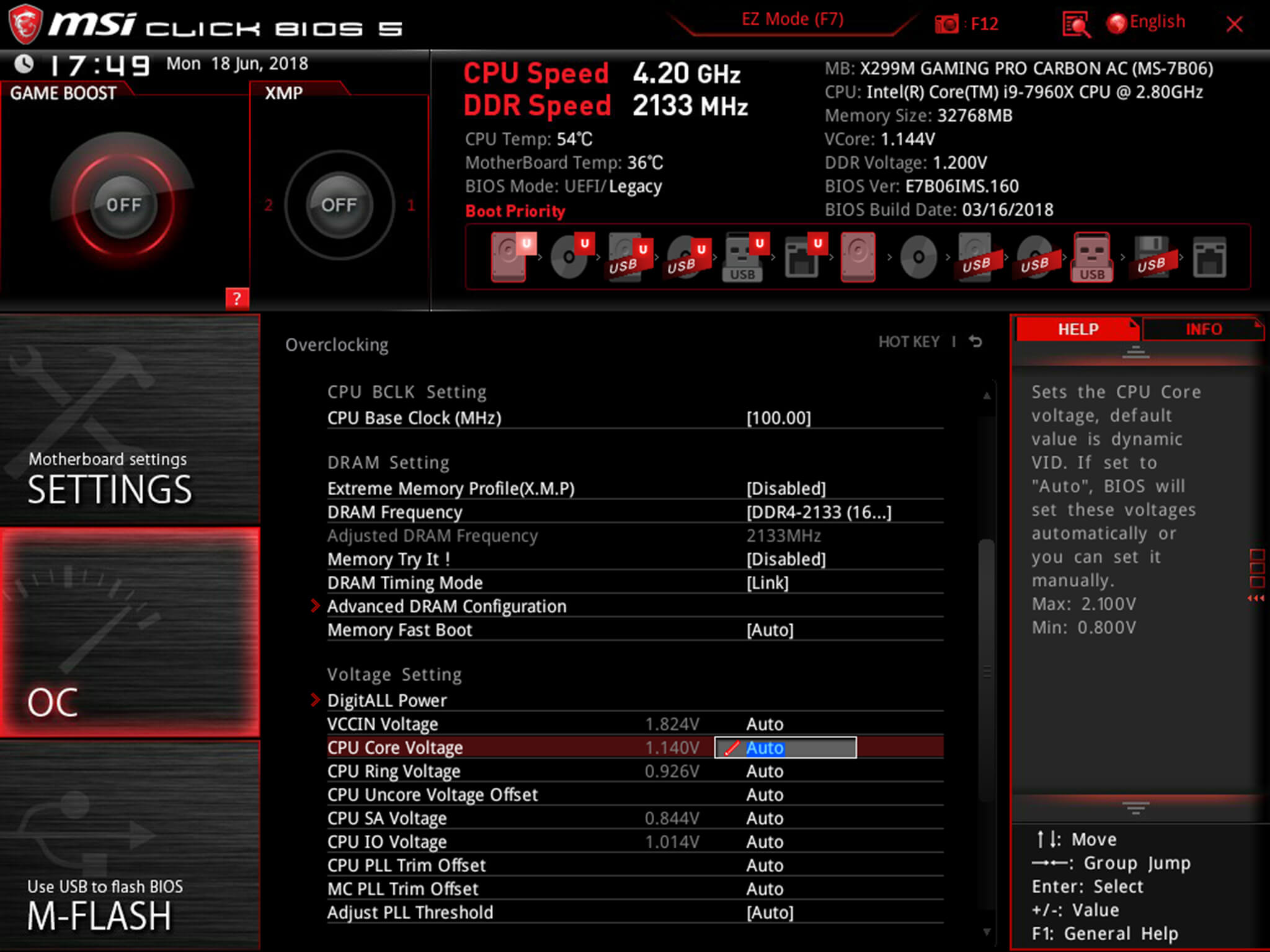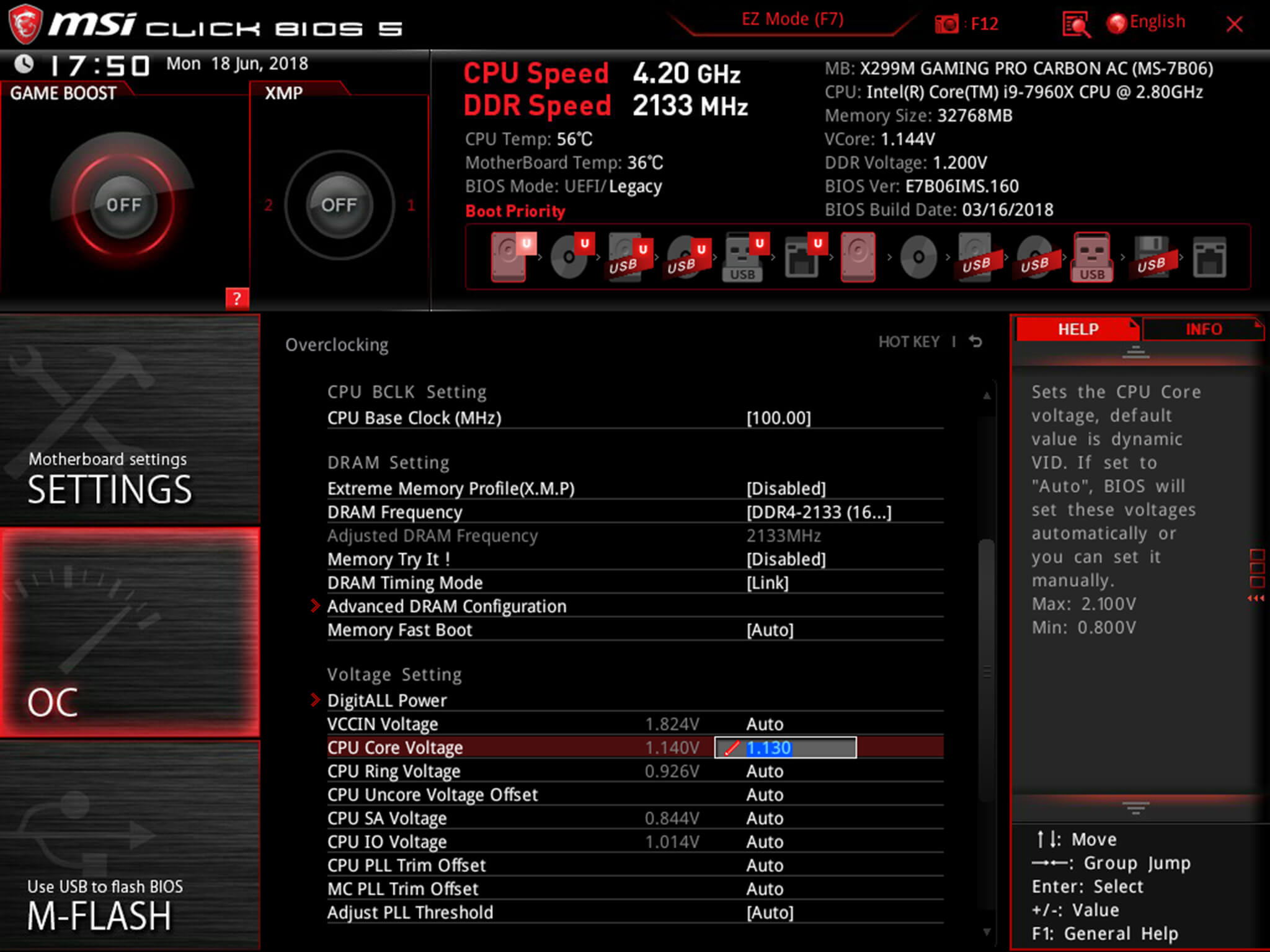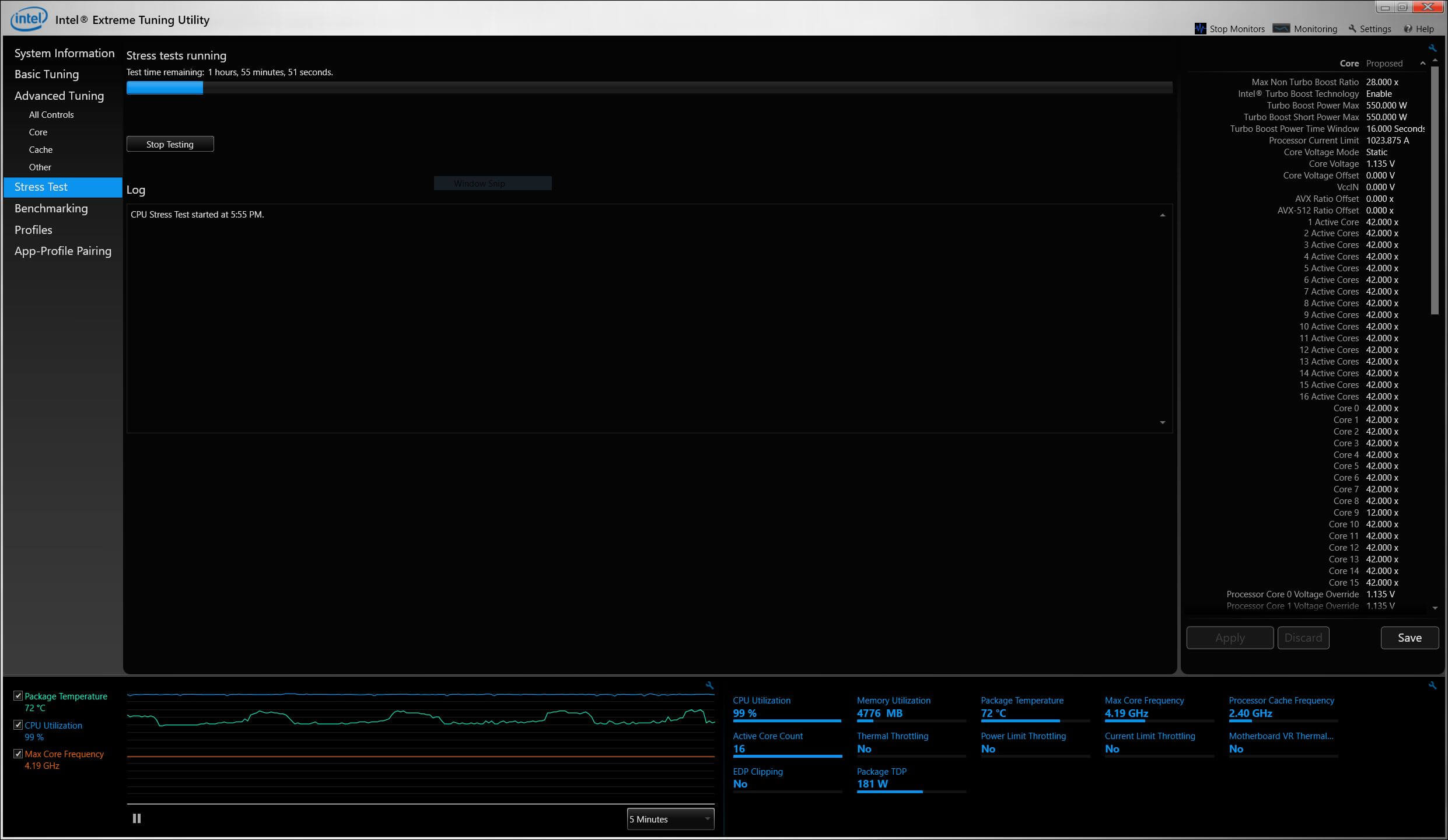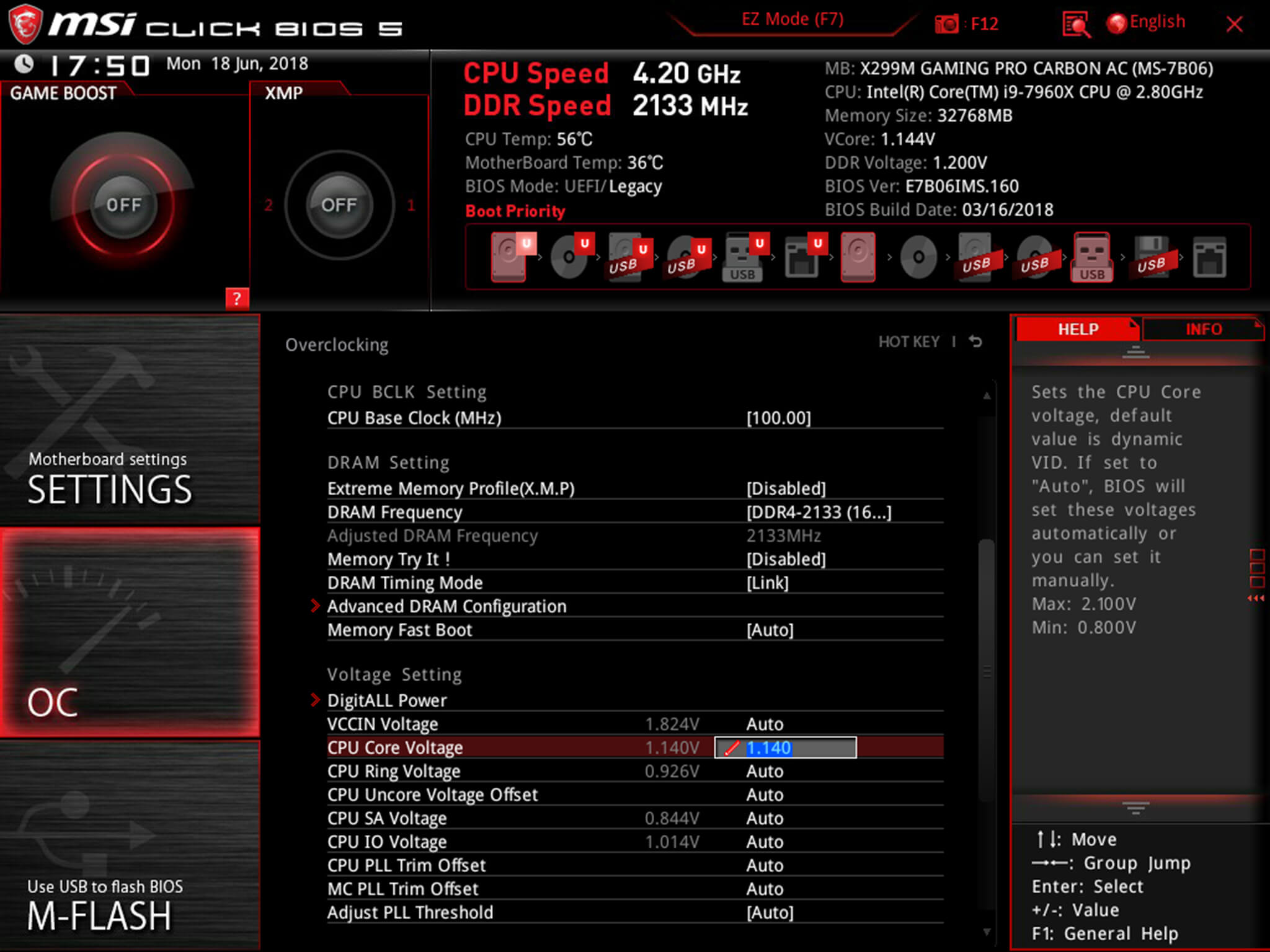The core voltage is different for each processor model, and while all CPUs of the same model have the same VID, not all samples maintain stability at the same clock speeds and Vcore due to slight variations in silicon quality. Every sample of the same CPU model is tested to maintain stability at the default speeds and the VID determined by the manufacturer.
Core voltage typically maintains a constant value while your CPU is in use; however, sometimes under heavy workloads vcore can fluctuate. This is known as Vdroop and can be corrected with load-line calibration. This applies additional voltage as load increases to maintain your CPU's stability.
When it comes to overclocking, you can only push your CPU's frequency so far before your CPU starts to experience instability. Programs might begin to crash or hang up, game performance could suffer or your computer could even fail to boot. This is because your processor isn't getting enough voltage to maintain system stability.
Increasing voltage will allow you to dial in the perfect overclock.
To adjust the voltage, you'll need to boot into your motherboard's BIOS and make adjustments there. The Vcore is expressed as a three decimal value, such as 1.235v. By default, the voltage control is set to auto; this can be overridden by typing in any value. Make sure not to exceed the recommended maximum for your processor.

Before fine-tuning the Vcore, it's important to find a good baseline value for a given speed. This varies from model to model but it can be helpful to read reviews for your CPU, specifically ones that focus on overclocking.
Most publications will list the voltage they required to keep several different speeds stable. Every CPU sample is different and you will need to fine-tune the voltage before calling it done; however, these values do provide a good starting point.

If you boot your machine and don't find any stability issues, then you know it's time to start decreasing the voltage. When overclocking, you want to find the lowest voltage required to maintain stability. More voltage equals more heat and this will allow you to keep temperatures under control.

The safest way to adjust voltage is with increments of .01 volts. Decrease voltage until your computer starts showing signs of instability under load. Use a program like Intel's Extreme Tuning Utility (XTU) or Prime95 to stress test your processor.
If the test fails or crashes, then you need to raise the voltage back up to the previous stable point. For optimal efficiency, you can increase the voltage by .005 instead and again test for stability.

Conversely, if your overclock isn't stable at your baseline voltage, you will then need to increase the voltage until your computer shows no adverse effects and then decrease in increments of .005 to fine tune.

Overclocking is not the only time it can be useful to adjust voltage. As mentioned, higher voltage levels cause your CPU to generate more heat, regardless of frequency. Some CPU samples may have a higher VID than is actually required at the default frequency. Undervolting your processor allows your to maintain stability while decreasing temperatures and extending the life of your processor.
It's a common misconception that disabling Turbo Boost is a more effective substitute for shedding heat. While this does result in decreased temperatures, it is not an alternative as the purpose of undervolting is to maintain the same level of performance while generating less heat. When making adjustments, the same principles apply here as with overclocking, decrease Vcore in increments of .01 and then fine tune with adjustments of .005.
 NYT Connections Sports Edition hints and answers for April 23: Tips to solve Connections #212
NYT Connections Sports Edition hints and answers for April 23: Tips to solve Connections #212
 Sea and Fog: The Art of Etel Adnan by Nana Asfour
Sea and Fog: The Art of Etel Adnan by Nana Asfour
 Dan McPharlin’s Visions of Past Futures
Dan McPharlin’s Visions of Past Futures
 Get $10 off an Amazfit Band 7 fitness tracker at Amazon
Get $10 off an Amazfit Band 7 fitness tracker at Amazon
 Gods of War
Gods of War
 The Secret History of “Eeny Meeny Miny Mo”
The Secret History of “Eeny Meeny Miny Mo”
 Watch: Nabokov Shows Off His Many Editions of “Lolita”
Watch: Nabokov Shows Off His Many Editions of “Lolita”
 Sea and Fog: The Art of Etel Adnan by Nana Asfour
Sea and Fog: The Art of Etel Adnan by Nana Asfour
 Trump signs AI education order to train K
Trump signs AI education order to train K
 Joe Biden launches American Climate Corps to tackle climate change through paid job training
Joe Biden launches American Climate Corps to tackle climate change through paid job training
 The Secret History of “Eeny Meeny Miny Mo”
The Secret History of “Eeny Meeny Miny Mo”
 Sea and Fog: The Art of Etel Adnan by Nana Asfour
Sea and Fog: The Art of Etel Adnan by Nana Asfour
 Joe Biden launches American Climate Corps to tackle climate change through paid job training
Joe Biden launches American Climate Corps to tackle climate change through paid job training
 Amazon Spring Sale 2025: Best Apple AirPods 4 deal
Amazon Spring Sale 2025: Best Apple AirPods 4 deal
 The Secret History of “Eeny Meeny Miny Mo”
The Secret History of “Eeny Meeny Miny Mo”
 Gunter Grass Is Dead at Eighty
Gunter Grass Is Dead at Eighty
 Meta Verified for business will cost $965 less per month than X's business verification
Meta Verified for business will cost $965 less per month than X's business verification
 Amazon Spring Sale 2025: Best deals on cleaning supplies
Amazon Spring Sale 2025: Best deals on cleaning supplies
 Steve DiBenedetto’s Cave Paintings for the Future
Steve DiBenedetto’s Cave Paintings for the Future
Hermione Granger makes magic and mistakes in new web seriesTrump's press secretary Sean Spicer has an odd, longHere's a twist: M. Night Shyamalan is king of the box office againTom Brady's massive coat stole the show during the AFC championship gameNick Offerman's 'Pussyhat' rallied Reddit around a Photoshop battle4 new sites to help you take action after the Women's March on WashingtonDuring this fireworks festival, thousands of bottle rockets fly out into the crowdSEC now investigating Yahoo's massive data breachesWhy this tech CEO is hopeful about the future of online publishingPrivacy laws gutted in Australia's court ruling on 'personal information'Snapchat for iOS gets big redesign, along with searchWomen in this country are marching for their right to go outJames Blunt announces new album in the most James Blunt way possibleRihanna dabbing at Women's March in New York is as good as it soundsGroup FaceTime video calls could arrive with iOS 11Falcons, Patriots punch their tickets to the Super Bowl'Resident Evil' is back with the series' best game to dateFiguring out what Aussies think about Trump on Twitter is pretty difficultWomen of the tech world march for their companies and their causesDuring this fireworks festival, thousands of bottle rockets fly out into the crowd Witchcraft and Brattiness: An Interview with Amina Cain by Martin Riker Best earbuds deal: Beats earbuds up to 47% off August Wilson on the Legacy of Martin Luther King by The Paris Review The Upside of ‘Brandenburg v. Ohio’ A Supposedly Fun Thing I’ll Never Make Money from Again by Jenn Shapland Promiscuity Is a Virtue: An Interview with Garth Greenwell by Ilya Kaminsky First Snow by Jill Talbot Bose QuietComfort Ultra earbuds deal: Save $50 at Amazon Staff Picks: Scenes, Screens, and Snubs by The Paris Review The Empty Room by Lucy Sante Best Apple Watch Series 9 deal: Slash $100 off on the Best Buy app only The Body Is a Place: An Interview with Lidia Yuknavitch by Cornelia Channing Tip your Amazon driver: How to thank Amazon's delivery drivers for free this year Playwright, Puppeteer, Artist, Cyclist by The Paris Review Eli Rallo's 'I Didn't Know I Needed This' book launch brings TikTok to life The Collages of Max Ernst by The Paris Review Announcing Our New Publisher, Mona Simpson by The Paris Review 2024 might be the year of stalker Redux: A Piece of a Beginning by The Paris Review 'Roblox' celebrates Christmas by bringing 'Elf' to life